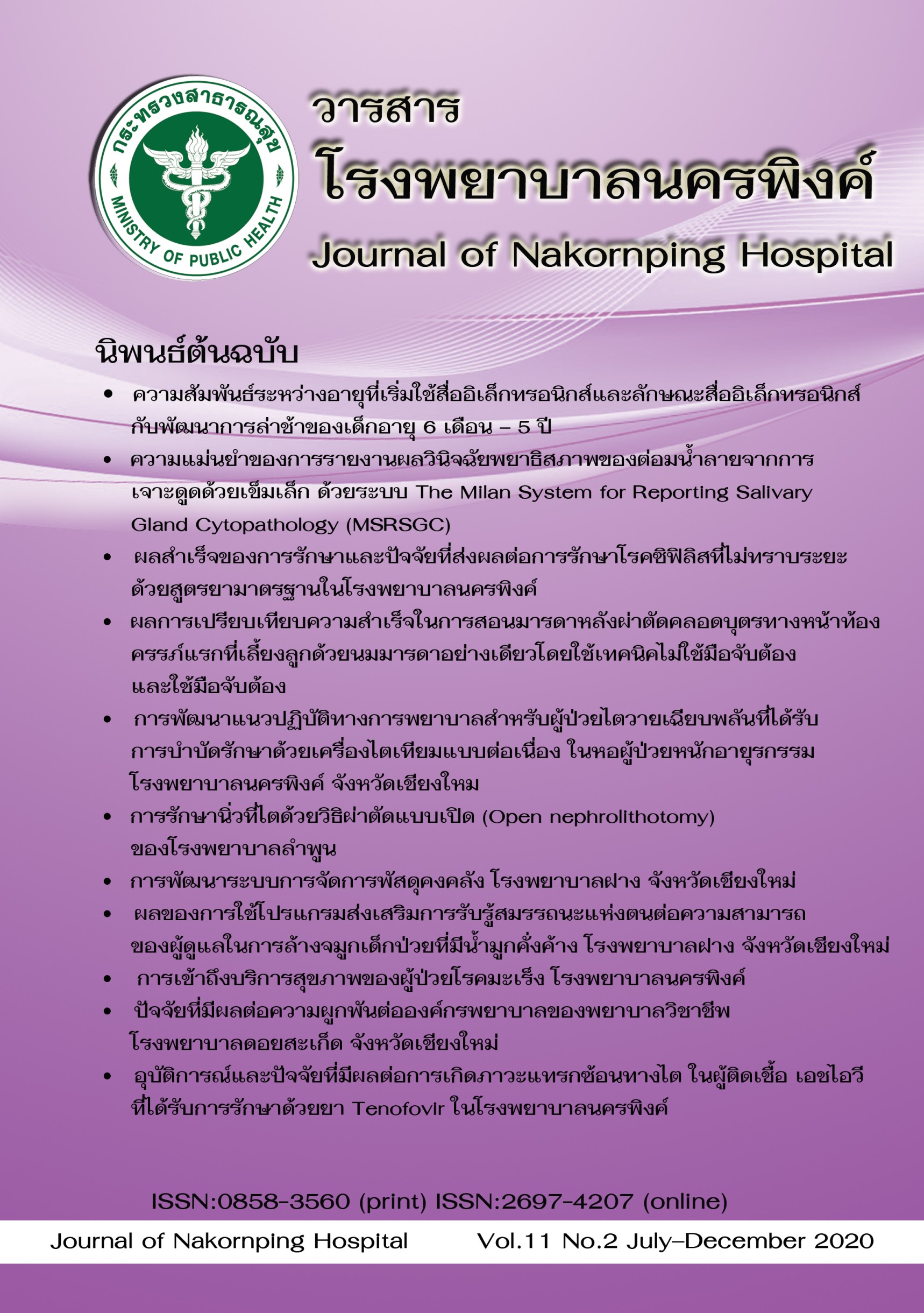Incidence and Factors associated with Tenofovir-induced nephrotoxicity in HIV infected patients in Nakornping Hospital
Keywords:
Nephrotoxicity, HIV, Tenofovir, Incidence, Risk FactorAbstract
Background :Tenofovir (TDF) is widely used as a component of first line antiretroviral regimens on the basis of its efficacy and tolerability in clinical trials. However, the use of TDF has been associated with nephrotoxicity.
The objective of this study was to evaluate the incidence and risk factors associated with TDF-induced nephrotoxicity among HIV-infected patients in Nakornping Hospital.
A retrospective cohort study was conducted on HIV-infected adult patients at the department of internal medicine Nakornping Hospital during January 2015 to December 2019. Data were extracted from electronic medical records. Nephrotoxicity was defined as > 25% decrease of baseline estimated glomerular filtration rate (eGFR). Risk factors were evaluated by multivariable logistic regression.
Of 1,960 HIV-infected patients included in this study, 1,135 were male (57.91%). The average age was 37.25 + 11.26 years. Nephrotoxicity was seen in 274 patients (13.98%). The median time to nephrotoxicity was 4.35 months (IQR=11.86).
Factors associated with nephrotoxicity were age > 50 years (Adj. OR=1.97, 95% CI 1.13-3.44, p=0.016), baseline CD4 less than 200 cell/mm3 (Adj. OR=6.36, 95% CI 3.90-10.36, p<0.001), pre-existing diabetes mellitus (Adj. OR=2.58, 95% CI 1.22-5.42, p=0.012) and ACEIs/ARB co-administered (Adj. OR=10.03, 95% CI 3.85-26.15, p<0.001).
TDF was associated with nephrotoxicity in HIV-infected patients. The significant risk factors for TDF-induced nephrotoxicity included age 50 and above, baseline CD4 lower than 200 cell/mm3, pre-existing diabetes mellitus and ACEIs/ARB. Patients treated with TDF, especially with risk factors should be monitored closely to prevent untoward adverse effect.
References
Department of Disease Control of Thailand, Bureau of AIDS, TB and STIs. Thailand National Guidelines on HIV/AIDS Treatment and Prevention 2017. Bangkok: Bureau of AIDS, TB and STIs; 2017.
Asawatwong S. Tenofovir and Risk of Deficient Renal Function in HIV/AIDS Patients at Krabi hospital. Krabi Medical Journal. 2018;1(1):35-43.
Patel KK, Patel AK, Ranjan RR, Patel AR, Patel JK. Tenofovir - associated renal dysfunction in clinical practice: An observational cohort from western India. Indian J Sex Transm Dis AIDS. 2010;31(1):30-34.
Koh HM, Kumar S. Tenofovir-induced nephrotoxicity: A retrospective cohort study. Med J Malaysia. 2016;71(6):308-312.
Chaisiri K, Bowonwatanuwong C, Kasettratat N, Kiertiburanakul S. Incidence and risk factors for tenofovir-associated renal function decline among Thai HIV-infected patients with low-body weight. Curr HIV Res. 2010;8(7):504-509.
Kiertiburanakul S, Chaisiri K, Kasettratat N, Visuttimak P, Bowonwatanuwong C. Monitoring of Renal Function among HIV-infected Patients Receiving Tenofovir in a Resource-Limited Settings. J Int Assoc Physicians AIDS Care. 2011;10(5):297-302.
Fernandez-Fernandez B, Montoya-Ferrer A, Sanz AB, Sanchez-Niño MD, Izquierdo MC, Poveda J, et al. Tenofovir Nephrotoxicity: 2011 Update. AIDS Res Treat. 2011;2011:354908. Available from: http://dx.doi.org/10.1155/2011/354908
Tun-Yhong W, Pamonsinlapatham P, Chinpaisan C. Tenofovir and Renal Toxicity at Cellular Level. Burapha Science Journal. 2017;22(2):248-259.
Voratanarat K. Tenofovir disoproxil fumarate-associated nephrotoxicity in patients with AIDS at King Chulalongkorn Memorial Hospital [dissertation]. Bangkok: Chulalongkorn University; 2008.
Petchkum P, Suphanchaimat R. Incidence and associated risk factors of nephrotoxicity due to Tenofovir in HIV-infected patients. Journal of Health Science. 2016;25(1):92-103.
Suzuki S, Nishijima T, Kawasaki Y, Kurosawa T, Mutoh Y, Kikuchi Y, et al. Effect of tenofovir disoproxil fumarate on incidence of chronic kidney disease and rate of estimated glomerular filtration rate decrement in HIV-1–infected treatment-naïve Asian patients: Results from 12-Year Observational Cohort. AIDS Patient Care STDS. 2017;31(3):105-112.
Tanuma J, Jiamsakul A, Makane A, Avihingsanon A, Ng OT, Kiertiburanakul S, et al. Renal dysfunction during tenofovir use in a regional cohort of HIV-infected individuals in the Asia-Pacific. PLoS One. 2016;11(8):e0161562.
The nephrology society of Thailand. Clinical Practice Recommendation for the Evaluation and Management of Chronic Kidney Disease in Adults 2015. Bangkok: The nephrology society of Thailand; 2015.
Lee JE, Lee S, Song SH, Kwak IS, Lee SH. Incidence and risk factors for tenofovir-associated nephrotoxicity among human immunodeficiency virus-infected patients in Korea. Korean J Intern Med. 2019;34(2):409-417.
Ojeh BV, Abah IO, Ugoagwu P, Agaba PA, Agbaji OO, Gyang SS. Incidence and predictors of tenofovir disoproxil fumarate-induced renal impairment in HIV infected Nigerian patients. Germs. 2018;8(2):67-76.
Downloads
Published
How to Cite
Issue
Section
License
The articles that had been published in the journal is copyright of Journal of Nakornping hospital, Chiang Mai.
Contents and comments in the articles in Journal of Nakornping hospital are at owner’s responsibilities that editor team may not totally agree with.



